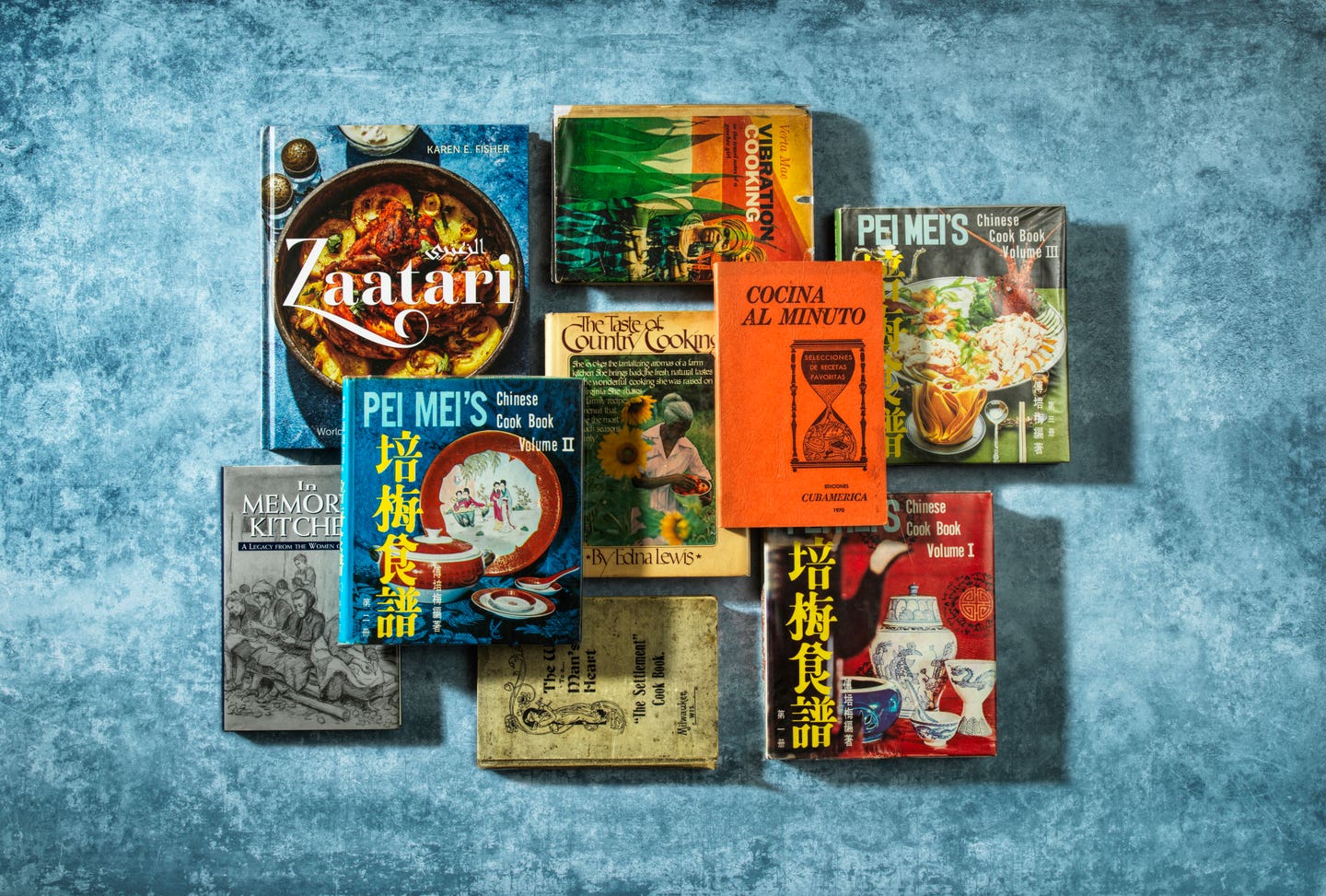
Cookbooks Have Always Been Political—Whether Readers Knew It or Not
For these authors, cooking isn’t just an escape—it’s an inherently political act.
In Zaatari, the world's largest Syrian refugee camp, the scents of roasting coffee, freshly baked khubz bread, and frying onions fill the air. As an ethnographer conducting research in the community of 83,000 on the Jordanian border, Karen E. Fisher has come to recognize these smells as an invitation to the community’s many gathering spaces. Even a simple breakfast here can be high art, an ornate assembly of home-cured olives, ful mudammas (cumin-scented fava bean stew), and tesqieh (chickpeas in garlicky yogurt). Since 2016, Fisher has worked with the women of the camp to gather their recipes into a community cookbook that bears its name: Zaatari. Far from being defined exclusively by hardship, the book channels the resilience of a people and of a neighborhood with its own rich food culture.
Making dishes from Zaatari—or any of the many 20th-century cookbooks that bring politics to the table—highlights what even some cookbook aficionados struggle to accept: The kitchen is not always an escape from the realities of the world. For many, cooking is an inherently political act, and any dish can represent an attempt at self-determination.
One of the first explicitly political recipe books published in the United States was The Settlement Cookbook. The 1901 manual compiled homemaking tips from a Milwaukee, Wisconsin community center founded by Progressive-era reformer Lizzie Black Kander to support Jewish immigrants. In addition to instructing readers on American dietary standards, Kander shared recipes drawn from what she cooked in her own Jewish household. While other cookbooks of the era inundated readers with meals featuring the bland English-style béchamel known as “white sauce,” Kander offered Czech pancakes, German spätzle, and borscht; in doing so, she underscored that progress shouldn’t mean the erasure of foreign cultures. In 1969, another volume similarly positioned diasporic cooking as a way to stay connected with one’s heritage: Pei Mei’s Chinese Cookbook, the first bilingual presentation of Chinese cuisine to American audiences. The author, Fu Pei-mei, fled to Taiwan in the aftermath of the Chinese Civil War, and her take on Chinese cooking was never politically neutral. As mainland China experienced upheaval during the Mao-led ’60s and ’70s, Fu promoted the diasporic preservation of Chinese cooking—from Cantonese roast pork to Shanghai-style zongzi—as a claim to cultural freedom.
Cookbooks often function as archives and historical records, especially for the voiceless and marginalized. One might wonder why the women prisoners of Theresienstadt thought to write one, given the brutal conditions they faced during their time at the Moravian concentration camp. Yet the book they created—recipes gathered and sewn together by Mina Pachter, who died before the camp’s liberation in 1944—chronicled Central European dishes like butter cakes and white asparagus as a source of conversation and comfort. In 1969, the precious volume was delivered to Pachter’s daughter, Anny Stern, who worked with late historian and SAVEUR contributor Cara de Silva to publish it as In Memory’s Kitchen. It was far from the first time a cookbook documented women’s ingenuity under repression: When food shortages arose in post-revolution Cuba, TV star Nitza Villapol adapted her recipes to the new reality in her 1958 book, Cocina al Minuto, which offered thrifty variations on traditional recipes like ropa vieja made with plantain peels. Villapol’s insistence on preparing traditional dishes, even with the barest of cupboards, was an act of political defiance and a defense of the Cuban right to pleasure.
Throughout the 1970s, a slew of new American cookbooks emerged that might be considered politics-forward. The “counterculture” movement eschewed processed foods, encouraged vegetarianism, and promoted engagement with non-Western cuisines. This shift sparked more appreciation in the publishing industry for the foods of communities of color, resulting in books like Vertamae Smart-Grosvenor’s Vibration Cooking. The 1970 volume, which Smart-Grosvenor filled with dishes that developed “in spite of slavery and oppression,” championed Black foodways as political resistance. By sharing hoppin' John, banana pudding, and other dishes beloved among Black communities, the poet and activist wrote against the notion that food was “something that only Julia [Child] and Jim [James Beard]” could understand. Six years later, another tome penned against the backdrop of the civil rights movement used food to amplify Black communion: Edna Lewis’s The Taste of Country Cooking.
It was an edible history of Freetown, Virginia, where a community of Black people freed from enslavement thrived, celebrating their sovereignty with roasted quail, coconut layer cakes, and dandelion wine. The book became a new American classic and a testament to the resilience of Black culture.
The works that follow in the wake of these women span the globe. As recent cookbooks celebrating the food of Armenia, Ukraine, Bosnia, and Palestine demonstrate, cooking is not only an accessible way to reckon with global conflict, but also a chance to gain knowledge, cultivate empathy, and shape perspectives, one meal at a time. For what is cooking but a way of living—in our homes, our nations, and the globe?
Keep Reading
Continue to Next Story










